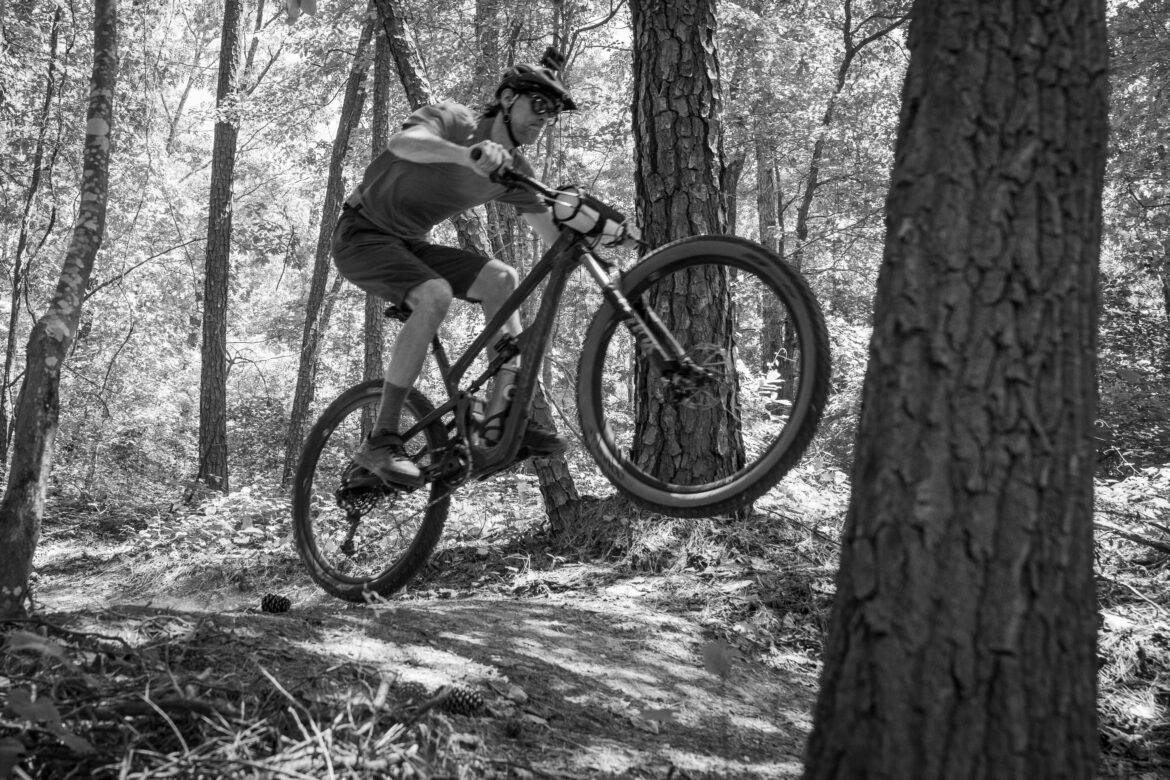
The Donnelly AVL mountain bike tire is billed as a variable conditions tire designed to excel in conditions similar to those found in the Pisgah National Forest outside of Asheville, NC. If you’ve never ridden Pisgah, just think roots and rocks, and assume a greater than 50% chance that your ride will involve either water, slippery trails, or both. I’ve been testing the Donnelly AVL on a couple of different bikes on trails in the southeast over the past several weeks, and here’s what I’ve learned about this relative newcomer to the MTB scene.
Donnely AVL tire specs

The Donnelly AVL is available in just one configuration really, though buyers can choose from either black or tan sidewalls. Either way, it’s a 2.5-inch, 29er tire with 120tpi construction with what the brand describes as a durable, protective layer that helps extend the life of the tire. Like the Donnelly GJT tire I recently reviewed, the inside of the AVL features a unique, orange-peel-like texture that seems to help sealant cling to the surface better than a completely smooth surface might.
The tire features a sturdy folding bead that I found locked easily into rims from both I9 and Reynolds. Donnelly claims the tire weighs 880g but the one I tested tips the scale at a significantly heavier 950g. This likely isn’t a tire that weight weenies are considering anyway; the sub-800g Donnelly LXV is a far better choice for cutting grams.
Looking at the tread pattern it’s clear the AVL is designed to provide good climbing and braking grip while still rolling fast and offering good bite in the corners. The stepped, pyramid shape of the trapezoidal center knobs is somewhat unique, as are the offset side knobs. There’s a lot going on here with repeating blocks of three center knob patterns, two transition knob sets, and a pair of repeating, deep-siped side knobs.
Mounted on a static, 30.5mm internal-width rim I found these tires actually measure about 57.5mm (2.26in). Moving up to a 32mm internal-width rim gives the tire a slightly wider contact patch that’s about 59.5mm (2.34in) which still falls short of the full 61mm/2.4in marked on the sidewall. However, with decently low pressure and some weight on the bike the tire width easily exceeds 2.4in. Donnelly recommends 20-45psi which is likely on the high side for many riders, and potentially influences the inflated size as well.



I tested the Donnelly AVL exclusively as a rear tire, in combo with a couple different front tires, on a couple different bikes. Each time the tire mounted easily, though the first time I rushed the tubeless setup and got a flat early in my ride. It seems the sidewall on one side didn’t get a nice coating of sealant; rolling the tire on its side fixed things right up and I didn’t experience another flat for any reason over roughly 150-200 miles of testing.
On the trail

As a rear tire I found the Donnelly AVL has a lot to offer on both the climbs and descents. With medium-to-short height center knobs the tire does a great job confirming to rocks and roots on technical climbs, and I found I rarely lost traction. While it might seem like chunky, tall knobs would provide more grip on technical trails, I’ve found it’s actually better to have more of the tire in contact with the trail at all times, especially when it comes to powering over greasy roots and muscling up and out of rocky streams. The AVL doesn’t feel overly draggy on the flats, falling somewhere between average- and fast-rolling tires.
The braking tread provides for controlled stops and I didn’t find it overly jittery or prone to stuttering. This wouldn’t be my first choice for loose trails but I did find it handles well in both dry and damp conditions, provided the overall trail surface is mostly firm. In corners the transition and side knobs are good, though I didn’t find them to be 100% predictable. I was surprised a few times to feel the tire starting to slip sideways in moderate turns, though I was always able to correct and never completely slid or washed out.
I’m generally a fan of more supple and lightweight, 120tpi tires, like the Donnelly AVLs, though obviously the tradeoff is a less stiff sidewall that’s prone to pinching, flopping, and burping. Running this as a rear tire I decided to add a few extra psi to compensate and minimize the risk of flats. The strategy paid off during my testing — no flats! — though that extra bit of pressure meant a slightly more harsh rear end, which was especially apparent on my hardtail. As a rear tire I might prefer a 60tpi version, or one with a re-enforced sidewall, if one were available in the future.
The AVL does a nice job clearing mud and clay, which comes in handy for places like Pisgah and here in Georgia where I live. After 150-200 miles of riding the tire appears to have suffered an average amount of wear, with a slight bias toward the faster-wearing end of the tire spectrum.
Pros and cons of the Donnelly AVL tire
Pros
- Easy setup
- Good for climbing technical trails
- Supple plus medium weight for nice ride feel
Cons
- Transition and cornering knobs are somewhat unpredictable
- Sidewalls aren’t up to snuff for the roughest riding
- Loses grip in loose conditions
Bottom line
The Donnelly AVL is a good rear tire for climbing technical trails in variable conditions from damp to dry. With supple construction, this light-duty trail tire can provide a nice ride feel at appropriate tire pressures, and generally handles predictably. However for loose conditions riders will want to look elsewhere.
- Price: $80
- Available at REI and other online retailers.









